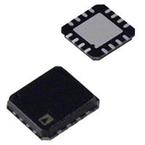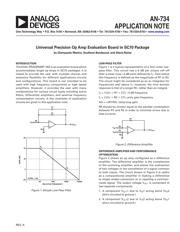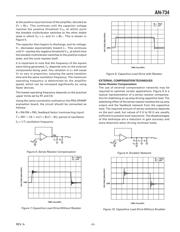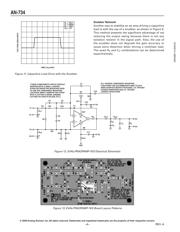下载

AN-734
APPLICATION NOTE
One Technology Way
•
P.O. B
ox
9106
•
N
orwood
, MA 02062-9106
•
T
el
TelT
: 781/329-4700
•
F
ax
:
781/326-8703
•
www.analog.com
INTRODUCTION
The EVAL-PRAOPAMP-1KS is an evaluation board which
accommodates single op amps in SC70 packages. It is
meant to provide the user with multiple choices and
extensive exibility for different applications circuits
and con gurations. This board is not intended to be
used with high frequency components or high speed
ampli ers. However, it provides the user with many
combinations for various circuit types including active
lters, differential ampli ers, and external frequency
compensation circuits. A few examples of application
circuits are given in this application note.
Figure 1. Simple Low-Pass Filter
Universal Precision Op Amp Evaluation Board in SC70 Package
by Giampaolo Marino, Sou ane Bendaoud, and Steve Ranta
LOW-PASS FILTER
Figure 1 is a typical representation of a rst-order low-
pass lter. This circuit has a 6 dB per octave roll-off
after a close-loop –3 dB point de ned by f
C
. Gain below
this frequency is de ned as the magnitude of R7 to R2.
The circuit might be considered as an ac integrator for
frequencies well above f
C
; however, the time domain
response is that of a single RC, rather than an integral.
f
C
= 1/(2
R7
C7); –3 dB frequency
f
L
= 1/(2
R2
C7); unity gain frequency
Acl = –(R7/R2); close loop gain
R6 should be chosen equal to the parallel combination
between R7 and R2 in order to minimize errors due to
bias currents.
Figure 2. Difference Ampli er
DIFFERENCE AMPLIFIER AND PERFORMANCE
OPTIMIZATION
Figure 2 shows an op amp con gured as a difference
ampli er. The difference ampli er is the complement
of the summing ampli er, and allows the subtraction
of two voltages or the cancellation of a signal common
to both inputs. The circuit shown in Figure 2 is useful
as a computational ampli er in making a differential
to single-ended conversion or in rejecting a common-
mode signal. The output voltage V
OUT
is comprised of
two separate components:
1.
A component V
OUT
1 due to V
IN
1 acting alone (V
IN
2
short circuited to ground.)
2.
A component V
OUT
2 due to V
IN
2 acting alone (V
IN
1
short circuited to ground.)
REV. A






